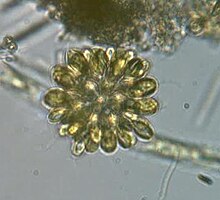Synurid
| Synurids | |
|---|---|

| |
| A colony of Synura sp. | |
| Scientific classification | |
| Domain: | Eukaryota
|
| (unranked): | |
| Superphylum: | Heterokonta
|
| Phylum: | |
| Class: | Synurophyceae Andersen, 1987
|
| Order: | Synurales Andersen, 1987
|
| Families | |
|
| |
The synurids (Synurales) are a small group of heterokont algae, found mostly in fresh water.
Characteristics[]

They are covered in silicate scales and spines. In Synura, these are formed on the surface of the chloroplasts,[1] two of which are usually present, but sometimes only one divided into two lobes is seen. The cells have two heterokont flagella, inserted parallel to one another at the anterior, whose ultrastructure is a distinguishing characteristic of the group. Both asexual and isogamous sexual reproduction occur.
Genera[]
Two major genera are included here, divided into species mainly based on the structure of the scales.
- Mallomonas species are free-living individual cells, usually 50-100 μm in length. They have ornate scales and generally long spines.
- Synura species occur as spherical colonies, with the cells oriented so that the flagella point outwards, each usually around 30 μm in length. The colonies are globular, rather than hollow, and spines are short if at all present.
Both are common plankton in lakes and ponds. In high concentrations, they dye the water yellow, and produce a distinctive odour.
To reproduce the parent cell splits into two daughter cells which get half of the parent cells scales. The new cells can regrow the scales and grow back into their original form.
History[]
The genus Synura was proposed in 1834 by the German microscopist Christian Gottfried Ehrenberg (1795–1876).[2]
The synurids were originally included among the golden algae in the order as the family Mallomonadaceae or as the family Synuraceae . They were formally defined as a separate group by Andersen in 1987, who placed them in their own class Synurophyceae, based on an earlier approach of more narrowly defining major lineages of chrysophyte algae by British phycologist David Hibberd.[3][4]
The Chrysophyceae and Synurophyceae are currently recognized as closely related taxa within the Stramenopiles.[5][6]
References[]
- ^ Barry S.C. Leadbeater (1990), "Ultrastructure and assembly of the scale case in Synura (Synurophyceae Andersen)", British Phycological Journal, 25 (2): 117–132, doi:10.1080/00071619000650111
- ^ See:
- Ehrenberg (1833). "Dritter Beitrag zur Erkenntniss grosser Organisation in der Richtung des kleinsten Raumes" [Third contribution to [our] knowledge of greater organization in the direction of the smallest realm]. Abhandlungen der Königlichen Akademie der Wissenschaften zu Berlin [Treatises of the Royal Academy of Sciences in Berlin] (in German): 145–336. From p. 281: Ehrenberg created a new family, Volvocina, " ... wozu ich die vier neuen Gattungen Chlamidomonas, Syncrypta, Synura, und Uroglena stelle." ( ... into which I place the four new genera Chlamidomonas, Syncrypta, Synura, and Uroglena.) [Note: According to p. 145, Ehrenberg's paper was first presented in 1832, revised somewhat, and published in 1834.]
- See also: AlgaeBase: Synura Ehrenberg, 1834
- ^ Hibberd, D. J. (1976). The ultrastructure and taxonomy of the Chrysophyceae and Prymnesiophyceae (Haptophyceae). Botanical Journal of the Linnean Society, 72,55–80
- ^ Hibberd, D. J. (1979). The structure and phylogenetic significance of the flagellar transition region in the chlorophyll c-containing algae. Biosystems, 11, 243–262
- ^ Grant J, Tekle YI, Anderson OR, Patterson DJ, Katz LA (March 2009). "Multigene Evidence for the Placement of a Heterotrophic Amoeboid Lineage Leukarachnion sp. among Photosynthetic Stramenopiles". Protist. 160 (3): 376–85. doi:10.1016/j.protis.2009.01.001. PMID 19282238.
- ^ W. Vyverman, G. Cronberg (March 1993). "Scale bearing chrysophytes from Papua New Guinea". Nordic Journal of Botany. 13 (1): 111–20. doi:10.1111/j.1756-1051.1993.tb00022.x.CS1 maint: uses authors parameter (link)
External links[]
| Wikimedia Commons has media related to Synurales. |
- Ochrophyta
- Heterokont stubs